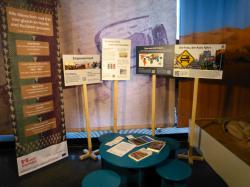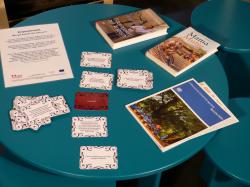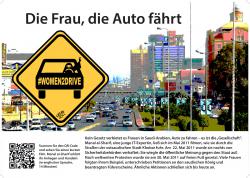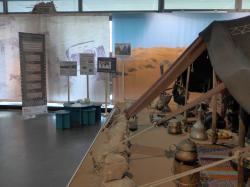How to do it step by step
1st Step:
Initial orientation
Visit the museum you will be working with and get an overview of the exhibition.
2nd Step:
Content selection
Conjointly choose the object and topic you want to work with. The form taken by each installation will depend very much on the specific museum you choose and its objects. Types of objects that you might connect to this development topic include objects typically (and stereotypically) connected to women's lives (e.g. traditional women's clothes or professions, the household, female artists, or famous women from the region).
Try to create a comprehensible and clear connection to the existing objects.
→ Try to stick as closely as possible to the thematic focus of the object you want to work with. Make connections to the region, the actors involved and the style of storytelling used in the object.
Choose an aspect of the topic that is both complex enough and well defined enough. Do you want to offer an overview of MDG 3? Or do you want to focus on a specific aspect like female
genital mutilation?
→ As gender is a huge and complex topic in which you can easily get lost, we recommend concentrating on one or two aspects. In our installation for example, we gave an overview by presenting some global facts, but then also presented a case study on the right of women drive.
Develop interesting methods that can be used to implement your idea. Check how much space will be available at the museum, what technical facilities the museum can offer, which target group you want to address and how much money you have available to invest.
→ Think small, start small. During implementation, new ideas will arise, so be prepared to save some money to invest later on! In our case, we added some interesting books on women's rights for visitors to read.
3rd Step:
Work plan
Develop a first draft of your idea, combining your ideas with those of your partners. This draft should already include a budget plan so that you can assess the feasibility of your idea. It should also include an implementation schedule. Produce a draft that everyone agrees with and send it to all your partners.
→ Include every single step in the production process, so that you factor in the small details. For example it may seem convenient to list only "production of cards", but you may also need to pay for a proofreader, a designer, copyright permissions, laminated paper and so on.
4th Step:
Subcontractors
Ask for quotes for every step of production. Try to get several quotes for each step so that you can choose the best offer. Add up the quotes, compare the total with your budget plan and adjust it, if necessary. In our case, we funded the installation from our own resources ( the museum society). So we chose the printer that we usually work with.
5th Step:
Content creation
Create and write down the content for the information panels. This is very time-consuming because researching details takes time. Ask your partners to proofread this first version so that you can clarify any misunderstandings at an early stage. Try to keep the text brief by limiting it to the key information only.
6th Step:
Graphic material and additional objects
Choose pictures, graphics and videos that reinforce the content. Ask the copyright owners if you can use their material for educational purposes. In some cases you might have to pay to use this material. UN Women, Unicef, WHO and other sources are helpful and generally grant permission to use and translate their material.
→ In most cases, you will be asked to submit forms via the Internet to obtain permission to reprint or use the material of international organizations. You can obtain permission faster if you directly call the person in charge. You can often find her/him on the organization's homepage. The same holds true for NGOs.
→ For the little "poll" that visitors can do via the QR code on their mobile device, we used the program "Survey Monkey". There are several options for the types of questions you might ask. Test them on your colleagues and friends. Are the questions easy and straightforward? Do they generate results that you can use?
7th Step:
Modelling test versions
Try out different tables and stools. Testing the big information boards in the size of your banner, you can use a beamer to magnify your graphic onto the wall in the wished size. A2-size boards can easily be reproduced through photocopying. So, you can see whether their size fits into the
overall arrangement.
→ Print out your banners and boards ensuring the colours are as authentic as possible.
8th Step:
The game
Collect data for the card game. We chose 37 events from women's and gender history that were/are important locally, regionally, nationally and internationally. There is an event on the (white) front and a date on the (red) reverse. The challenge is to put the cards into chronological order without looking at the reverse. Write down the rules of the game and test the game on colleagues and friends. Are the rules clear?
→ Try to include stories and events from your town or region as well.
→ Produce more than one deck of cards, since visitors will take some away as "souvenirs", while others might get lost in some other way. Although the game is designed in such a way that the odd missing card will not ruin the game, eventually you will have to replace the deck.
9th Step:
Producing the table
Talk to your carpenter about your ideas and start this process as soon as possible. Once again, you can choose between working with a local company or other types of partner. The Natural History Museum of Nuremberg often cooperates with public and municipal institutions like the municipal job creation company, which results in reduced costs . However, on the down side, you cannot schedule completion for a fixed date, which might lead to delays.
Check the carpentry work on arrival. It sometimes gets damaged in transit (as in our case).
10th Step:
Final checks
Finalize the banner and boards with the designer. Get a printout on paper to see the true colours.
Correction loops: Several correction cycles will make the final product look more professional. Ask the designer for two or three checks. Pay a professional to do the proofreading if you included this in your budget plan.
→ Identify the representatives from the museum that need to give their blessing to the final product. Try to keep the circle small to save time, while ensuring the correction process is transparent to all actors involved.
11th Step:
Installing the object in the museum
Finalize everything. Once you give the "go-ahead", the designer will send the final design to a print shop. Consider how you will fix the banner (on the ceiling? on the wall?). You might need some extra materials for this. To fix the board we used discarded hat stands.























